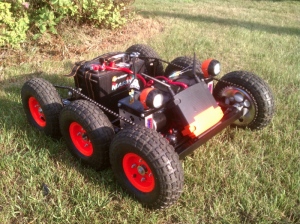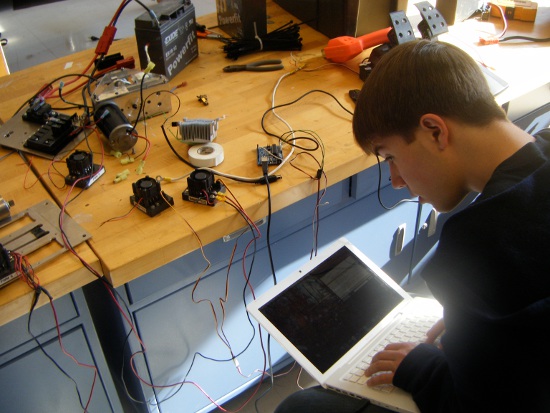Drive for Innovation talks with us at Maker Faire
Posted: August 9, 2011 Filed under: News Leave a commentJust wanted to give a shout out to the guys over at Drive for Innovation, as I really enjoyed speaking with them. We were at Maker Faire Detroit a few weeks ago to show off a few of our latest projects and received a lot of interest in what we’re developing. Here’s a short video of me speaking with Brian Fuller of Drive for Innovation:
Drive for Innovation – All hail Mantis, the open-source robot
We’ve got more videos/projects on the way, so stay tuned!
Open Source Robot Controls
Posted: July 22, 2011 Filed under: Projects 64 CommentsI’ve been playing around with some ideas for an Arduino/Netduino robot control system the past few months. I knew that I wanted to be able to control my robots from an Android phone, PC, or any other WiFi enabled device. I also knew that I wanted the system to be small and simplistic, but also powerful and extensible. The reason I went with an Arduino (Ethernet Pro) or a Netduino Plus for the controller was the low cost, ease of programming, and the embedded ethernet port. I coupled the onboard ethernet with a wireless router so that I could connect and transmit data to the robot wirelessly. Here are the results of our first robot build with this system. The robot was affectionately named Mantis.
The Tech Junkies Episode #7 – Open Source Robots
Posted: July 14, 2011 Filed under: Vidcast Episodes Leave a commentIn this episode we show how to build your own open source robot control system using IPGamepad and other open source software we’ve written. Make sure to visit the project page at ipgamepad.googlecode.com. We also show off our latest robot called Mantis. By building the controls around a Netduino, the robot is extremely extensible and can receive commands from any WiFi enabled device.
A project write-up is on the way and should be hitting the site in the next few days. Until then, check out the Google Code page for all the details of the control system.
Robot Project (Mantis) Teaser Video
Posted: July 11, 2011 Filed under: Projects Leave a commentHere it is, folks. Just finished our latest and greatest robot project. We edited together a quick teaser video to show off a bit of what the robot (affectionately named “Mantis”) can do.
You should see a full blown episode in the next day or two of exactly how the control system works and how you can build your own! If you’ll be around the Detroit area at the end of the month, we will be showing off Mantis and a few other robots at Maker Faire Detroit! We will be located in the i3 Detroit hackerspace booth. Hope to see you all there!
Eric
Green Screening in Final Cut Pro X
Posted: July 11, 2011 Filed under: Projects Leave a commentHey all,
I wanted to make a quick video showing off how to do chroma keying (Green Screening) in the latest Final Cut Pro X for anyone who may be unfamiliar with the new version. Enjoy!
Eric
New Android/Arduino App – ipgamepad
Posted: May 4, 2011 Filed under: Projects 6 CommentsJust wanted to post a little update here about the latest project I’ve been working on called ipgamepad. If you’re looking for a video, don’t worry. We’ll be documenting this fully in the next episode.
In a nutshell, ipgamepad is a simple app that runs on any Android device and acts as a virtual gamepad controller that transmits the control data wirelessly. Right now it’s extremely simplistic in nature (just 2 analog sticks), but I have plans to build out a full controller with buttons and switches. My motivation behind building this is for controlling Arduino/Netduino robots over WiFi.
If you’re like me, you probably have a spare wireless router lying around the house and there’s a good chance you’ve got an Android device accessible to you. With those 2 components you’re literally a microcontroller + ethernet interface away from a wireless control system. On the Google Code page, I’ve also provided an Arduino sketch that you can run if you have an Ethernet shield. You can directly control servos or speed controllers from the Arduino, providing a complete robot control system.
If you’re an Android developer and are interested in helping with the project, let me know! I definitely could use the help developing the app and there are a lot of things to improve/implement before I consider the app anywhere near polished.
The video episode will be following soon with a full explanation and robot demo. Enjoy the code until then!
Projects in the Pipeline
Posted: April 1, 2011 Filed under: News 3 CommentsHello Tech Junkies fans!
Just wanted to give an update on our status and the projects we’ve been working on the past several months. In the future the format of our show may change slightly. We are currently planning on releasing shorter “quick tip” videos in addition to our larger project videos.
That being said, here are a few things we’ve been developing and will be creating video demonstrations of in the near future:
-Building large scale robots (Arduino-based control system + Android Remote Control)
-MIDI instrument creation
-Simplified RFID Door Unlocking Circuits perfect for temporary installations (Dorms, Apartments, etc…)
-RFID card spoofing (hand wrapped coils and microcontrollers)
We’re also planning on being at Maker Faire Detroit 2011 to demonstrate some of these projects. Hope to see you there and make sure to check back for new videos and project write-ups!
Action Sports Game Timer
Posted: November 19, 2010 Filed under: Projects Leave a commentTimer for airsoft and paintball games that has multiple game modes (defense/attack/capture). Timer must be “diffused” by a player in defense mode, armed/diffused in attack mode, or 2 teams fight over control in capture (king of the hill) mode.
This is currently a work in progress. More details and code coming soon.
The Tech Junkies Episode #6 – OpenWRT Jukebox
Posted: May 25, 2010 Filed under: Vidcast Episodes 2 CommentsIn this episode of The Tech Junkies, Ben and Eric show how to hack an Asus WL-520gu wireless router into a music playback device. By loading the OpenWRT firmware onto the router and adding a USB sound card, it is possible to convert this cheap/powerful router into a streaming box to be placed anywhere your WiFi is in range. Now you can build your own shoutcast/icecast receiver for cheap and get music wirelessly to any room in your home.
Electric Go Kart
Posted: November 19, 2009 Filed under: Projects 1 CommentA complete conversion from a gasoline powered go kart into an electric go kart featuring a full control system with feedback.
Pictured here are the four motors powering the vehicle, motorcycle batteries, brake lights, electronic speed controllers, and various other components of the control system.
The dashboard of the vehicle is outfitted with an LCD screen that displays current power being sent to the left and right drives. A potentiometer inserted into the steering shaft allows the system to dynamically alter motor speed based on turning.
Reprogramming the software running onboard the system.
The system uses a modified set of steering wheel/pedals from a racing video game. The system has variable speed control by use of this method.
The electronic bits that make everything actually work.









